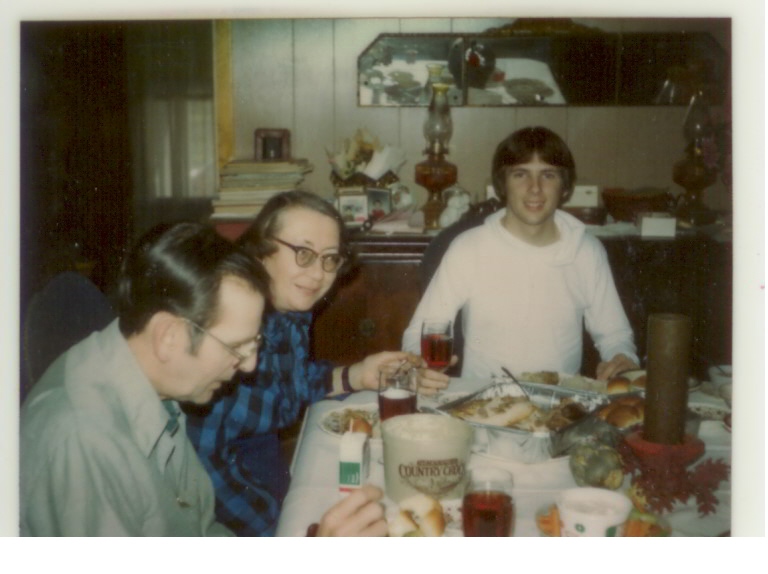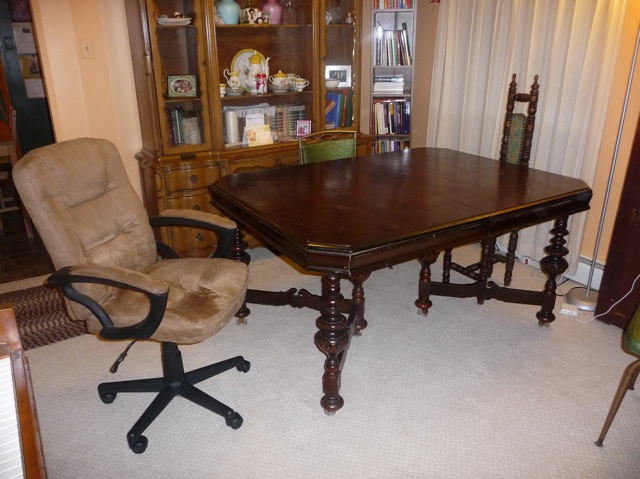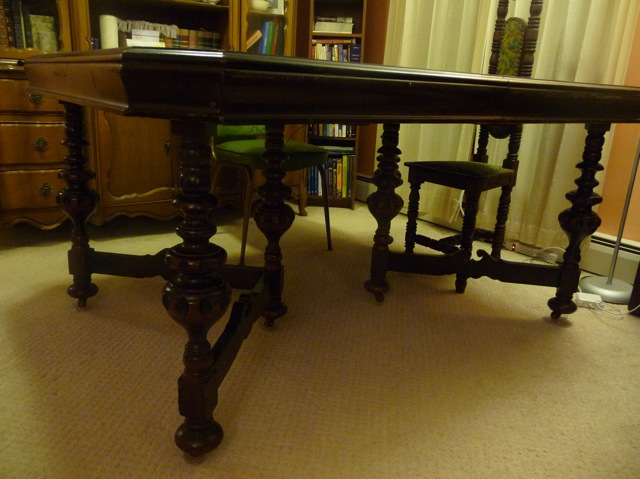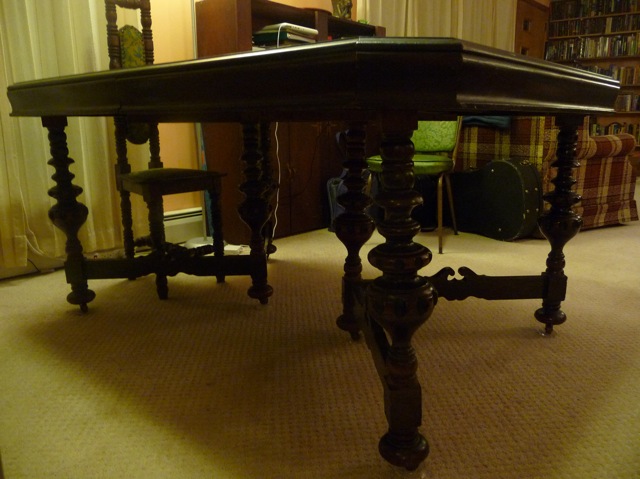“Within this chamber lies a room built far away,
Brought east, then north, by wheel times eight and bed and bed;
No walls it has, but pillars six uphold its roof, and in another day
It was a fortress grand for Chris and Fred.”
Such read a mysterious clue, one of a series in a treasure hunt I put together recently for a special occasion. It led the way to the table which now stands in our living room — a table that has made a remarkable journey through time and space:
I don’t actually know where the table was built, but it was likely “far away.” It is a “room” in the sense that Chris and I imagined it to be such when we played under it as kids. It was “brought east” from Illinois in one truck and then up here in another — eight wheels and two (truck) beds. Those six ornate “pillars” holding up its “roof” seemed like many more when we were small. Back then, it felt like a forest of them. Certainly the warm, dark paneling of our old dining room added to the atmosphere of age and otherworldliness.
It’s just occurred to me why there seemed to be so many more legs back then. It was because the table was surrounded by six chairs cushioned in blue, their legs carved in the same style as the table’s. So there really was a forest of finely-wrought pillars.
It came humbly to our house back then, like nearly all our furniture: my parents went shopping at the Goodwill and the Salvation Army in Springfield, and this table, chairs, and a matching buffet all came from one of those — I’m not sure which it was, but I’m certain my mom picked the set out and got it all at a very reasonable price.

A Thanksgiving dinner, early eighties? — at the dining room table when it stood in the room that would become Mom’s office
For many years, this rickety, dark-gleaming table served as the board for the laying out of special feasts — Christmas dinner, Thanksgiving meals, Easter feasts, and New Year’s Eve festivity snacks.
Its chief function for all the rest of the year was as Mom’s big, ongoing project table. Her day-to-day work took place at her kitchen table, of which she’s written eloquently elsewhere. Her typing was done at her desk. But this dining room table was for things that couldn’t be finished all at once, but that needed leaving out and accessible. Jigsaw puzzles took slow shape on it; tax-related booklets and forms piled up there as winter gave way to spring. Research projects, grant proposals, and photo albums waited among kits for making Japanese dolls, church choir music, and quilting hoops with their attendant cloth squares, scissors, backing, pin cushions, needles, and spools of thread. Each of these objects took center stage in their proper time. (Mom would sit at the table, quilting, while Dad watched TV in the next room, so Mom knew all their favorite shows by sound alone, as if they were radio broadcasts. She impressed me with her ability to recognize the cast of Star Trek by their voices.)
Although the table was primarily Mom’s workshop, she gladly shared it with me when I was home and needed a work space. One winter, much of the editing of Dragonfly took place on that table in the dining room’s gentle murk.
Farther back, in junior-high and high-school days, I spent happy hours designing dungeons there for our fantasy role-playing troupe, and many a grand session of actual Dungeons & Dragons gaming took place around that table.
If only pictures of it in those years existed! We’ll just have to do it with words. Near one end of the table was the hearth and the white stone fireplace. Next (moving clockwise), a set of windows looked down from the dining room into the lower room where Dad had his easy chair and TV. These windows originally opened to the outside, but we left them in place when the lower room was added on — so I could stick my face close to the open window and talk with Dad in the chamber below, which felt zany and magical somehow — a window between rooms, and everyone able to call to one another easily from various parts of the house. What’s more, Mom applied stained-glass stickers over the panes in those windows, so it was like being in a chapel . . . and, I kid you not, a life-sized suit of armor stood beside the windows, towering over the famous table. Then came the brown wooden bookcase (which also made the move here, to our current home) and the vestigial half-partition, a testament that the dining room had once been divided into two rooms but was now one large space. And all the plush blue chairs with their elaborate legs were crowded in cozily between bookcase and table’s edge. Not far from the other end was Mom’s piano. The buffet against the room’s north wall finished out the square.
After my parents passed away, when I lived for a year back in their house, sorting things out, the table became my base of operations. In addition to all its usual mountains, it held my computer. I wrote the first Agondria stories then and there. I first corresponded with the friends that drew me to Pittsburgh. I watched Seasons 6 and 7 of Buffy and Season 1 of Veronica Mars, all at that table. I managed to ease a printer into the mix on an end-stand close by. As the house emptied in preparation for the Great Auction, other furniture was moved out to one fate or another, but I knew I couldn’t let the table go. I carefully took it apart, and when I returned to Japan, the tabletop and its legs went into my storage room at the old house in Taylorville . . . and there they waited in the dark, amid the books and the films and all the other treasures of the past . . . and time went by. More than once I thought fondly of the table and wondered if it would ever stand again in a place I called home.
Well, the fulness of time came. I returned from Japan, and when I loaded up things to haul to Pittsburgh, the table and the buffet were among them. For two years in McKees Rocks, the table again became the holder of ongoing projects, a work surface, the place for entertaining and feeding guests, and the center of writers’ meetings. The people who had first made me curious about the Uncanny City were now sitting around my table with me, discussing writerly quandaries and questions. On one of our first dates, the girl who would become my wife sat at the table with me, playing her guitar as we sang hymns together.
And now at last, the old dining room table has come truly and fully into its own again. I don’t know who or how many people used it before my mom spied it among the jumbled furniture in the second-hand shop and brought it home. I think it must have been well and happily used, for it has about it an air of wholesomeness and tranquility. Certainly it has absorbed nearly fifty years of my family’s laughter and labors. It needed some structural reinforcing when it got here — it’s come by many roads and borne great burdens, and it had grown wobbly; it’s been taken apart and put back together with mismatched hardware more times than anyone can count. Now more permanent screws have gone in, so that I don’t think it will be disassembled again until its long life is utterly played out. It’s more stable than it’s been in all the years I’ve known it.
Now my wife and I eat some meals at it; it’s where we serve our guests. We put our computers and our books and papers on it, and we work and talk there, facing each other. And ever beneath our wrists, under our elbows, around our knees, the table creaks and silently remembers all the things it’s held, all the dreams that have taken shape on its scarred top, all the minds and hearts that have met around it to be nourished in the most important ways.
If you visit us with your small children, we’ll let them clamber and sit beneath it, if they care to. A room, you know, looks different when you peer out at it through a grove of beautifully-tooled columns . . . when you’re safe and sheltered in a chamber without walls, wrapped in the comfortable whispers of the past.


